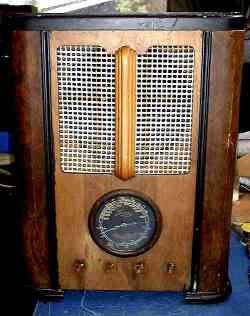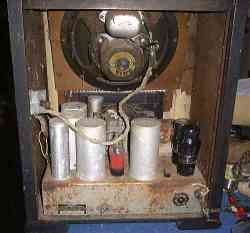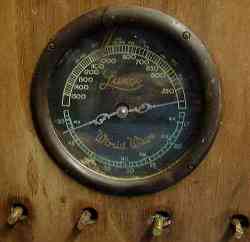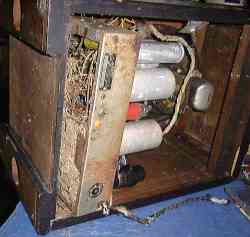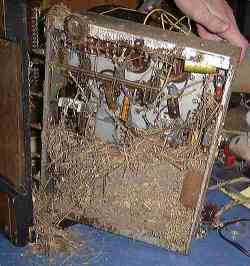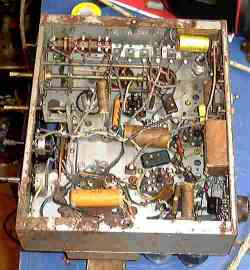|
This radio is a bit unusual. It is not a common brand. Junior bought it through an online auction. Luxors were made by Radio (1936) Ltd, the same people who made Ultimates etc.
Click on any of these photos to see a large, higher definition picture. As can be seen, especially from the large pictures, the condition is a bit rough. The grille cloth is a piece of hook and latch rug backing. It looks surprisingly reasonable! There are cracks down each curved front corner, and the speaker has a small hole in it, easily repaired. By checking resistances of the voice coil, field coil and output tranny, it appears the electro-mag speaker is working. The tuning knob shaft is seized, but should free up okay, and the dial needle is a bit bent. Under the chassis there is apparently a lot of hay and pine tree needles etc where something has obviously made a nest in there. Not the first radio we've had like that! Yeah, well, there is a bit of stuff in there! Quite a bit. After vacuuming it out, it was possible to see the deteriorated, cracked and chewed wiring and paper capacitors etc. So quite a few parts will need to be replaced. The small square, oblong block fastened on the rear of the chassis, on the right, is a .47 mfd capacitor. I have never seen one quite like it before. Another thing I've not seen before, and a lot of other collectors haven't either, is the drum on the tuner shaft that the dial cord winds around, is made from the lid of a paint can. Apparently some manufacturers made a few radios using this system, as there was a great shortage of parts during the 2nd World War. What's left of the dial cord is actually a piece of broken string. The first thing to do was get the chassis out. This was a bit difficult as the mounting bolts had rusted in. Eventually, with a lot of CRC and moving the bolts back and forward and slowly winding them out, one came OK. However, the other one broke off ! Then the junk was all vacuumed out. Next, I had to replace the power cord as the insulation was all rotting and wires were showing through. After this, some of the wiring, where insulation was suspect, was replaced. Plus some of the capacitors that were showing signs of damage. At this stage, I measured resistances to make sure there were no shorts in the power transformer, or anywhere else, and the on/off switch was turning on and off correctly. Everything appeared to be about right. Time to apply power. Plug into the RCD power protector. Turn RCD power on. Turn on radio switch. KAPOW!! Smoke, and a flash, and a bang. Ooopps. Something's wrong, somewhere. RCD had operated. This suggested there was a power leak going to earth (or ground, for you Americans) somewhere. No amount of metering showed where. Okay, turn radio on and then try hitting the RCD on button again. No problem. The dial lights lit up, although a bit down on light output, and the valve filaments glowed. Nothing else, no sound, no nothing. However I could see why the lights were not full bright. A wirewound resistor that shouldn't be there, and some of the voltages were a bit suspect. After a while the speaker field coil was also getting very hot. Shouldn't happen. Must be one of the electrolytic capacitors faulty. Sure enough. One that had been replaced by, or for, a previous owner was shot. Relaced that and no more heat, and voltages came right. Time to turn off the radio, to check a few other things. Use the volume control to turn it off. KAPOW!! Hmmm. Been down this road not so long ago. Bit of blackening showing on the switch, this time. Digital meter says it still works. However there has to be a problem there somewhere. Turning on and off both quickly and slowly showed up nothing. I wonder. Digital meters are a bit slow to react. Wonder if there's a problem that might show up with an analogue meter. Yup, I could just get a very small needle deflection as it turned on or off. The meter needle movement was just discernible as it was so quick. But obviously long enough to earth the mains power. Gotcha. With some more replacement caps, and cleaning of valve pins and sockets etc, we had a bit of audio. When touching grid caps and turning the wave band switch, we had some sound, and the phono input also worked. However, still no actual radio. Eventually I found a broken wire on one of the coils, but it was Litz, cotton covered wire, and very, very short. I managed, eventually, to get a bit of wire soldered to it, and joined the other end to the terminal. Plug her in. Yes!! We're in business. However there's a lot of whistling etc. Quick clean of the valve shield, to be sure of earthing, improved it. Find a shield for another valve that should have had one.... Great! A bit of quick tuning then improved things considerably. Now some cleaning up, a proper tune, etc, and we should have a pretty good performer, by the look of it, on broadcast, anyway. Haven't tried shortwave yet. Plus the tuner has to be cleaned, as the vanes appear to be touching in places, although they look straight, and a new dial cord on the old paint can lid!
|
Lost my navigation menu? Click here.
